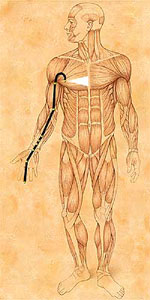Acu-Health Medical Clinic, Inc.

Traditional Chinese medicine is a range of traditional medical practices used in China that developed over several thousand years. These practices include herbal medicine, acupuncture, and massage
Tai Qi (martial arts / physical exercise), Tui´na (massage) and Feng Shui (environmental balance). 
Processes of the human body are interrelated and constantly interact with the environment. Practicioners of Chinese Medicine look for the signs of disharmony in the external and internal environment of a person in order to understand, treat and prevent illness and disease.
There are several schools of theory within the modern Chinese Medicine community. One of the most popular is the theory of the Five Elements. Proponents of this system use the relationship of five elements and the meridians or channels of energy in the human body to bring forces back into balance. For instance, if their diagnosis shows an excessive Yang condition in an energy related to a "fire" element, they may look for the cause as being either a Yin or weak condition in the "water" element (not enough water to control the fire), or they may find an Yang condition in the "wood" element (too much wood feeding the fire).
Now when you consider the "fire" as the heart, the "water" as the kidneys, and the "wood" as the liver, you can begin to see how a typical treatment may be configured. This also explains the reason why the practicioner may ask a lot more questions than a typical Western physician as they inquire about seemingly unrelated topics. A Western physician would seldom ask if you have trouble urinating or other kidney-related questions like a craving for salt when you go for a heart checkup, yet surprisingly, Western science has led to many similar conclusions (excessive salt can be bad for your heart).
The theory itself is simple but the relationships and diagnosis can become quite complex with creation cycles and destruction or controlling cycles, etc. Most body functions are divided into Yin/Yang tendencies, then subdivided into elements or qualities.
Another important difference in Eastern and Western medicine is that every traditional Oriental diagnosis is individual and unique. Two persons with the same symptoms may receive completely different treatments because the cause of their "imbalances" may be different. Oriental medicine looks for the "causes" of the disease, not necessarily treating the symptoms directly.
Elements |
Wood |
Fire |
Earth |
Metal |
Water |
Flavors |
Sour |
Bitter |
Sweet |
Pungent |
Salty |
Colors |
Green |
Red |
Yelow |
White |
Black |
Influences |
Wind |
Heat |
Dampness |
Dryness |
Cold |
Organs |
Liver |
Heart |
Spleen |
Lungs |
Kidney |
Senses |
Eyes |
Tongue |
Mouth |
Nose |
Ears |
Emotions |
Anger |
Joy |
Pensiveness |
Sadness |
Fear |
Body Part |
Tendon |
Pulse |
Muscles |
Skin |
Bone |
Additional Resources
12 Primary Meridians, The 8 Extraordinary Qi Vessels, Ear Acupuncture Points, Historical Timeline (Part I), Historical Timeline (Part II), Historical Timeline (Part III) |